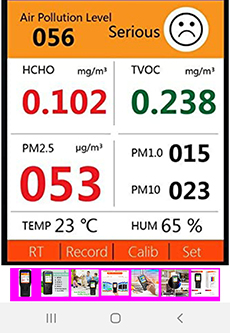Powys Safety Solutions > All Services > Air Quality Monitoring
Air Quality Monitoring
Air Quality Monitoring:
HCHO, TVOC
Ultrafine Dust:
PM10, PM2.5, PM1
Formaldehyde HCHO
Formaldehyde is a naturally occurring organic compound. Volatile organic compounds (VOC) are the most common and the most dangerous substance groups with regard to indoor air exposure)* Formaldehyde* (*HCHO*) is also the most important carcinogen in outdoor *air* among the 187 hazardous *air* pollutants (HAPs)
TVOC (*total volatile organic compounds*)
Acceptable *levels of TVOC* ranges from 0.3 to 0.5 mg/m3 of concentration.
From 0.5 mg/m3 of *TVOC* concentration *level* onwards the concern is
considered to be considerable or high.
10 Most Common VOCs
- Benzene.
- Butanal.
- Carbon Disulfide.
- Dichlorobenzene.
- Ethanol. Found in: glass cleaners, dishwasher detergents and laundry detergents.
- Formaldehyde. Found in: floor lacquers and certain molded plastics.
- Terpenes. Found in: fragrant products such as soap or laundry detergents.
- Toluene. Found in: paint.
The most typical particulates in the air are:
- PM1 – particles <1 μm in size. (the most dangerous) Examples: dust, combustion particles*, bacteria and viruses.
- PM2.5 – particles <2.5 μm in size. Examples: pollen, spoors and other organic particles.
- PM10 – particles <10 μm in size. Examples: coarser fine dust and organic particles.
When inhaled, PM10, PM2.5 and PM1 impact the body in different ways. Their ability to be trapped in the body, where they may form deposits, will depend on their size and whether they can pass through the walls of our airways





